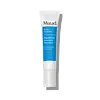What's inside
What's inside
 Key Ingredients
Key Ingredients

 Benefits
Benefits

 Concerns
Concerns

 Ingredients Side-by-side
Ingredients Side-by-side

Salicylic Acid 2%
MaskingWater
Skin ConditioningAlcohol
AntimicrobialHamamelis Virginiana Water
AstringentPropanediol
SolventPentylene Glycol
Skin ConditioningGlycerin
HumectantSilica
AbrasiveButylene Glycol
HumectantPolyacrylate Crosspolymer-6
Emulsion StabilisingC12-15 Alkyl Lactate
EmollientAesculus Hippocastanum Seed Extract
Skin ConditioningAvena Sativa Kernel Extract
AbrasiveUrea
BufferingYeast Amino Acids
HumectantTrehalose
HumectantInositol
HumectantTaurine
BufferingBetaine
HumectantThymol
AntimicrobialTerpineol
MaskingHydroxyphenyl Propamidobenzoic Acid
Skin ConditioningButyrospermum Parkii Butter
Skin ConditioningShea Butter Ethyl Esters
Emollient4-T-Butylcyclohexanol
MaskingDisodium EDTA
Sodium Hydroxide
BufferingSalicylic Acid 2%, Water, Alcohol, Hamamelis Virginiana Water, Propanediol, Pentylene Glycol, Glycerin, Silica, Butylene Glycol, Polyacrylate Crosspolymer-6, C12-15 Alkyl Lactate, Aesculus Hippocastanum Seed Extract, Avena Sativa Kernel Extract, Urea, Yeast Amino Acids, Trehalose, Inositol, Taurine, Betaine, Thymol, Terpineol, Hydroxyphenyl Propamidobenzoic Acid, Butyrospermum Parkii Butter, Shea Butter Ethyl Esters, 4-T-Butylcyclohexanol, Disodium EDTA, Sodium Hydroxide
Salicylic Acid 0.5%
MaskingWater
Skin ConditioningAlcohol Denat.
AntimicrobialGlycerin
HumectantXanthan Gum
EmulsifyingPinus Pinaster Bark Extract
AntioxidantCaprylyl/Capryl Glucoside
CleansingSalix Nigra Bark Extract
Skin ProtectingXylitylglucoside
HumectantAnhydroxylitol
HumectantSodium Benzoate
MaskingXylitol
HumectantPropanediol
SolventSantalum Album Wood Oil
PerfumingPotassium Sorbate
PreservativeSodium Cocoyl Glutamate
CleansingGlucose
HumectantCitric Acid
BufferingGlyceryl Caprylate
EmollientPolyglyceryl-6 Oleate
EmulsifyingThymus Vulgaris Leaf Oil
AntimicrobialChlorella Vulgaris Extract
Skin ConditioningSodium Surfactin
CleansingLactic Acid
BufferingSodium Lactate
BufferingFarnesol
PerfumingSalicylic Acid 0.5%, Water, Alcohol Denat., Glycerin, Xanthan Gum, Pinus Pinaster Bark Extract, Caprylyl/Capryl Glucoside, Salix Nigra Bark Extract, Xylitylglucoside, Anhydroxylitol, Sodium Benzoate, Xylitol, Propanediol, Santalum Album Wood Oil, Potassium Sorbate, Sodium Cocoyl Glutamate, Glucose, Citric Acid, Glyceryl Caprylate, Polyglyceryl-6 Oleate, Thymus Vulgaris Leaf Oil, Chlorella Vulgaris Extract, Sodium Surfactin, Lactic Acid, Sodium Lactate, Farnesol
 Reviews
Reviews

Ingredients Explained
These ingredients are found in both products.
Ingredients higher up in an ingredient list are typically present in a larger amount.
Glycerin is already naturally found in your skin. It helps moisturize and protect your skin.
A study from 2016 found glycerin to be more effective as a humectant than AHAs and hyaluronic acid.
As a humectant, it helps the skin stay hydrated by pulling moisture to your skin. The low molecular weight of glycerin allows it to pull moisture into the deeper layers of your skin.
Hydrated skin improves your skin barrier; Your skin barrier helps protect against irritants and bacteria.
Glycerin has also been found to have antimicrobial and antiviral properties. Due to these properties, glycerin is often used in wound and burn treatments.
In cosmetics, glycerin is usually derived from plants such as soybean or palm. However, it can also be sourced from animals, such as tallow or animal fat.
This ingredient is organic, colorless, odorless, and non-toxic.
Glycerin is the name for this ingredient in American English. British English uses Glycerol/Glycerine.
Learn more about GlycerinPropanediol is an all-star ingredient. It softens, hydrates, and smooths the skin.
It’s often used to:
Propanediol is not likely to cause sensitivity and considered safe to use. It is derived from corn or petroleum with a clear color and no scent.
Learn more about PropanediolSalicylic Acid (also known as beta hydroxy acid or BHA) is a well-known ingredient for treating skin that struggles with acne and clogged pores. It exfoliates both the skin's surface and deep within the pores to help clear out buildup, control oil, and reduce inflammation.
Unlike AHAs (alpha hydroxy acids), salicylic acid is oil-soluble. This allows it to penetrate into pores which makes it especially effective for treating blackheads and preventing future breakouts.
Salicylic acid is also known for its soothing properties. It has a similar structure to aspirin and can calm inflamed or irritated skin, making it a good option for acne-prone skin that is also sensitive.
Concentrations of 0.5-2% are recognized by the U.S. FDA as an over-the-counter topical acne product.
It can cause irritation and/or dryness if one's skin already has a compromised moisture barrier, so it's best to focus on repairing that before introducing this ingredient into your routine.
While salicylic acid does not increase sun sensitivity, it’s still important to wear sunscreen daily to protect your skin.
If you are looking for the ingredient called BHA or Butylated Hydroxyanisole, click here.
Learn more about Salicylic AcidWater. It's the most common cosmetic ingredient of all. You'll usually see it at the top of ingredient lists, meaning that it makes up the largest part of the product.
So why is it so popular? Water most often acts as a solvent - this means that it helps dissolve other ingredients into the formulation.
You'll also recognize water as that liquid we all need to stay alive. If you see this, drink a glass of water. Stay hydrated!
Learn more about Water